|
Displaying items by tag: Hudson River School

The Hudson River School Art Trail will open for the season on June 22, 2013.The trail boasts guided hikes, which are organized by the Thomas Cole National Historic Site in Catskill, New York and take visitors on a tour of the vistas, mountains and valleys that influenced the Hudson River School painters including Thomas Cole (1801-1848), Frederic Edwin Church (1826-1900), Asher B. Durand (1796-1886), Jasper Francis Cropsey (1823-1900), and Sanford Gifford (1823-1880).
The Hudson River School Art Trail is divided into a number of large geographic areas and allows visitors to walk in the footsteps of some of the most significant artists of the 19th century. The Hudson River School was the first major art movement to sweep America and it dominated the visual arts for over 50 years. The trail includes the home of Thomas Cole who is credited with founding the Hudson River School; Olana, the home of Frederic Edwin Church, an important figure in the movement; and views of the landscapes that are featured in the artists’ paintings.
The Hudson River School Art Trail was expanded last year, more than doubling its size from its original 8 sites in New York to 20 sites in New York, New Hampshire and Massachusetts.

In February 2013, the Fred L. Emerson Foundation and the Seward House Museum in Auburn, New York announced that they would sell a significant painting by the English-born American artist and founder of the Hudson River School, Thomas Cole (1801-1848). The sale of the work, titled Portage Falls on the Genesee (1839) is intended to benefit the institution, which opened to the public in 1955 and became a registered National Historic Landmark in 1964.
Portage Falls was given to the American politician William H. Seward while he was the governor of New York prior to the Civil War. Seward went on to serve as Secretary of State under Abraham Lincoln and Andrew Johnson and was a dominant figure in the Republican Party during its formative years. After his death in the 1950s, his home and its contents, which included 15,000 items including books, furniture, and works of art, were donated to the Fred L. Emerson Foundation. The Foundation opened the Seward Museum in 1951 and it became a fully independent, not-for-profit institution in 2009; the Cole painting was retained by the foundation.
The work, which depicts what is now Letchworth State Park in western New York, has been on view at the Seward Museum for 170 years and not everyone is pleased with the Foundation’s decision to sell it. A group known as the Seward Legacy Preservation, which formed in April 2013, includes descendants of Seward, and is poised to fight to restore the painting to its former place in the Seward House.
Seward’s great-great-grandson, Ray Messenger, also voiced his opposition to the sale. Although he served as the president of the Seward House’s board until 2009, Messenger was shocked by the decision. On Tuesday, May 7, 2013, Messenger asked a judge to make him the administrator of Seward’s estate, the initial step in filing a lawsuit to block the sale.
Portage Falls, which measures roughly 7 feet by 5 feet, was said to be worth around $20 million dollars in 2007. If the painting is sold, the Foundation and the Seward Museum plan on splitting the profit. The painting is currently being kept in a secure storage location.

Maine Sublime: Frederic Edwin Church’s Landscapes of Mount Desert and Mount Katahdin will open on June 9, 2013 at Olana in Hudson, NY. Olana State Historic Site was the home of Frederic Edwin Church (1826-1900), a major figure in the Hudson River School, and includes the artist’s studio. The villa is a mixture of Victorian, Persian, and Moorish styles and overlooks the Hudson River valley, the Catskill Mountains, and the Taconic Ridge.
The upcoming exhibition focuses on the 50-year period during which Church traveled and painted landscapes of Maine. Maine Sublime presents 10 oil and 13 pencil sketches from Olana’s collection and many of works will be on public view for the first time. The show will include loans from the Portland Museum of Art, the National Gallery of Art in Washington, D.C., and two private collections.
Church first visited Maine in 1850 and spent six weeks on Mount Desert. In 1852, Church explored the Mount Katahdin region and in the coming decades he would continue to visit and be captivated by Maine’s natural beauty. The plein-air sketch Wood Interior Near Mount Katahdin (circa 1877) is one of the works that has never been on public view but will be part of the upcoming exhibition.
Maine Sublime will be on view at Olana through October 31, 2013. The exhibition will then be on view at the Cleveland Museum of Art through the summer of 2014.
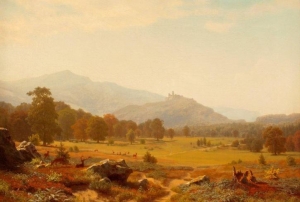
The Thomas Cole National Historic Site in Catskill, NY is currently hosting the exhibition Albert Bierstadt in New York & New England. Guest curated by Anne Blaugrund, former director of National Academy Museum in New York, the exhibition features a wide selection of Albert Bierstadt’s (1830-1902) east coast paintings.
Bierstadt (1830-1902) a German-American painter best known for his lush landscapes of the American west, also spent time capturing the natural beauty of the White Mountains, the Hudson Valley, and New England in his work. All of the works on view were created between the late 1850s and 1880s and range from oil sketches to finished paintings. Albert Bierstadt in New York & New England is the 10th annual presentation of 19th century landscape paintings at the Thomas Cole site.
The Thomas Cole National Historic Site, which is also known as Cedar Grove, is comprised of the home and studios of Thomas Cole (1801-1848), the founder of the Hudson River School of painting. A National Historic Landmark, the site aims to communicate Cole’s profound influence on American art to a broader modern audience.
Albert Bierstadt in New York & New England is on view through November 3, 2013.
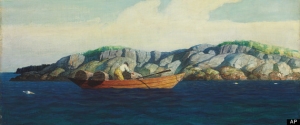
On April 26, 2013 Christie’s announced the sale of Three Generations of Wyeth: The Collection of Eric and Cynthia Sambol, which will take place on May 23, 2013 as part of its American Art auction in New York. Comprised of thirteen works – one by N.C. Wyeth (1882-1945), six by Andrew Wyeth (1917-2009), and six by Jamie Wyeth (b. 1946) – it is one of the largest collections of Wyeths Christie’s has ever sold.
Eric Sambol, a 53-year-old New Jersey businessman, became captivated by the work of Andrew Wyeth after a school trip to the Metropolitan Museum of Art in 1976 to see the exhibition Two Worlds of Andrew Wyeth: Kuerners and Olsons. Years later in 2000, after building an impressive collection of Hudson River School and maritime paintings, Sambol acquired his first Andrew Wyeth painting, Flat Boat. With the help of his wife Cynthia, a landscape designer, the couple’s collection grew to include works by Andrew’s father, N.C. Wyeth, and Andrew’s son, Jamie Wyeth.
Highlights from the collection include Andrew Wyeth’s Rocky Hill, an emotionally wrought watercolor of his dog Nell, which is expected to garner between $1.8 million and $2.4 million; Jamie Wyeth’s Lighthouse Dandelions, which draws on the family’s close connection to Maine and is expected to sell for $250,000-$350,000; and N.C. Wyeth’s Norry Seavey Hauling Traps Off Blubber Island, which was painted as a gift to Roger Scaife, a friend of the artist and editor at Houghton Mifflin and is expected to bring $300,000 to $500,000.
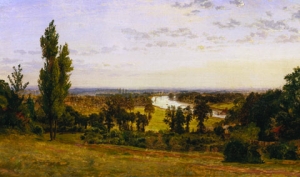
The Panoramic View: The Hudson and the Thames, which is currently on view at the Hudson River Museum in Yonkers, NY, focuses on the panoramic vista, a form that became popular among artists in the late 18th century. The term panorama was originally coined by the Irish painter Robert Barker (1739-1806) to describe his wide-angle paintings of Edinburgh and London. The form was ideal for members of the Hudson River School and other artists entranced by the natural world as it allowed them to capture the sweeping grandeur of the landscapes that inspired them.
The Panoramic View includes works by Robert Havell, Jr. (1793-1878), an English artist who emigrated from London to New York and painted both the Hudson and the Thames; founder of the Hudson River School, Thomas Cole (1801-1848); and Jasper Francis Cropsey (1823-1900), a first-generation member of the Hudson River School. The exhibition features loans from galleries, private collections, and museums including the Museum of Fine Arts, Boston, the Metropolitan Museum of Art, and The New-York Historical Society.
A fully illustrated catalogue accompanies The Panoramic River, which is on view through May 19, 2013.

In February, the Fred L. Emerson Foundation and the Seward House Museum in Auburn, New York announced that they would sell a significant painting by the English-born American artist and founder of the Hudson River School, Thomas Cole (1801-1848). The sale of the work, titled Portage Falls on the Genesee (1839) is intended to benefit the institution, which opened to the public in 1955 and became a registered National Historic Landmark in 1964.
Portage Falls was given to the American politician William H. Seward while he was the governor of New York prior to the Civil War. Seward went on to serve as Secretary of State under Abraham Lincoln and Andrew Johnson and after his death his home and its contents were donated to the Fred L. Emerson Foundation. The Foundation opened the Seward Museum but it became a fully independent, not-for-profit institution in 2009; the Cole painting was retained by the foundation.
The work, which depicts what is now Letchworth State Park in western New York, has been on view at the Seward Museum for 170 years and not everyone is pleased with the Foundation’s decision to sell it. A group known as the Seward Legacy Preservation has formed and will hold their first meeting at the Auburn Public Theater in Auburn, New York on Monday, April 29, 2013. Members of the organization, which include descendants of Seward, will fight to restore the painting to its former place in the Seward House. The painting is currently being kept in a secure storage location.
Portage Falls is said to be worth millions of dollars, which the Foundation and the Seward Museum plan on splitting when the painting sells.
These were the candid and elated words of newspaper correspondent Charlotte Ricker when, in 1882, she reached the summit of New Hampshire’s South Twin Mountain along with the first group of women ever to ascend the peak. During the latter half of the nineteenth century, Ricker was one of a larger group of women who played pioneering roles in the exploration of the American outdoors and lived impressive lives as writers, poets, hikers, and landscape painters. The achievements of these women—who broke the bounds of imposed gender restrictions to carve out lives of accomplishment, adventure and independence—appear all the more extraordinary when one considers the historical and social context within which they took place.
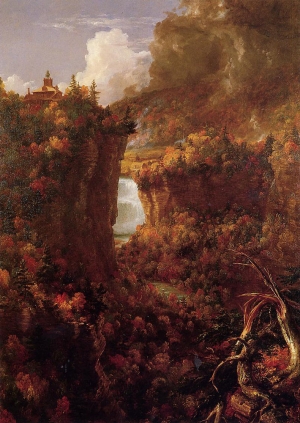
A significant painting by Thomas Cole (1801-1848), the English-born American artist who founded the Hudson River School, will be sold to benefit the Seward House Museum in Auburn, New York. Portage Falls on the Genesee (1839) was given to the American politician William H. Seward (1801-1972) while he was the governor of New York prior to the Civil War. Seward went on to serve as Secretary of State under Abraham Lincoln and Andrew Johnson.
The painting, which depicts what is now Letchworth State Park in western New York, has been a part of the Seward Museum’s collection for decades. Seward’s home and contents were donated to the Fred L. Emerson Foundation in the 1950s by Seward’s grandson, William Henry Seward III. The Seward House opened to the public in 1955 and became a registered National Historic Landmark in 1964. The museum became a fully independent, not-for-profit museum in 2009 and the Cole painting was retained by the foundation.
The recent discovery of the painting’s value and the subsequent need for greater security prompted officials to put the work up for sale. Funds from the sale will be split between the Emerson Foundation and the Seward House Museum. The museum plans to use its portion of the proceeds to further its preservation mission. Portage Falls on the Genesee is being kept in a secure storage location until the sale is official.
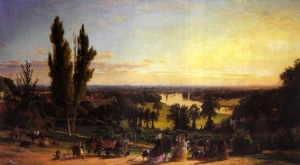
Days after the British government placed an export ban on two important works by the English painter, George Stubbs (1724-1806), officials have announced that they will take similar measures to keep a landscape painting of a London park by American Hudson River School artist, Jasper Francis Cropsey (1823-1900), in the U.K.
The export ban placed on Cropsey’s Richmond Hill in the Summer of 1862 gives the British government time to raise money to keep the painting in the country rather than having it sold to a foreign buyer. The government will need to come up with about $7.83 million in order to keep the painting, which has been in British collections for 150 years, in the U.K. Richmond Hill is important to British culture because it draws connections between American and British landscape paintings of the 19th century. It is one of the only British landscapes by an American artist to remain in the U.K.
The export ban will keep the Cropsey painting in the U.K. until April 7, 2013 and may be extended to August 7, 2013 if a potential British buyer has been found. The British government placed a previous export ban on Richmond Hill in 2000.
|
|
|
|
|